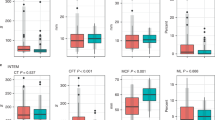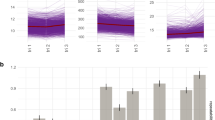Abstract
Objective:
The American College of Obstetrics and Gynecology Committee on Obstetric Practice recently endorsed delayed cord clamping at preterm delivery. However, the committee report expressed the concern by some practitioners that delayed clamping or cord milking might induce hyperviscosity in preterm neonates. To address this issue we: (1) established reference ranges for whole-blood viscosity among preterm neonates (viscosity reference ranges had previously been reported only in term neonates) and (2) determined the effect of umbilical cord milking at deliveries <32 weeks gestation on subsequent blood viscosity measurements.
Study design:
This was a prospective study in two Neonatal Intensive Care Units. Blood viscosity was measured using a cone and plate viscometer. Associations were sought with gestation, hematocrit/hemoglobin and mean corpuscular volume. Reference ranges were determined for preterm infants <32 weeks gestation. Then, after umbilical cord milking at deliveries <32 weeks, viscosity was measured at birth and again during the 12 h after birth. In neonates with viscosities >95th % range, we sought signs of hyperviscosity (plethora, hypotonia, hypoglycemia, hyperbilirubinemia, thrombocytopenia).
Result:
Viscosity at higher and lower sheer rates were linearly related (n=32, r=0.971). Within the range of hematocrits measured (29–63%) viscosity correlated with hematocrit (r=0.877) and hemoglobin (r=0.853) but not with erythrocyte size (r=0.179). Viscosity was related to gestational age (n=58), primarily due to the lower hematocrits at lower gestational ages. In the 12 h after cord milking viscosity ranged from 3.1 to 9.5 centipoise. Three of twenty preterm, neonates had viscosities >95th % reference range. However, all values were well below those where hyperviscosity is defined in term neonates and all lacked features of hyperviscosity.
Conclusion:
Cord blood viscosity is directly proportional to hematocrit/hemoglobin, lower at early gestation and not associated with erythrocyte size. Cord milking at preterm delivery is associated with a low risk of clinical hyperviscosity. Practioners should not refrain from cord milking at preterm delivery because of a concern that it will commonly cause neonatal hyperviscosity.
This is a preview of subscription content, access via your institution
Access options
Subscribe to this journal
Receive 12 print issues and online access
$259.00 per year
only $21.58 per issue
Buy this article
- Purchase on Springer Link
- Instant access to full article PDF
Prices may be subject to local taxes which are calculated during checkout



Similar content being viewed by others
References
Hosono S, Mugishima H, Fujita H, Hosono A, Minato M, Okada T et al. Umbilical cord milking reduces the need for red cell transfusions and improves neonatal adaptation in infants born at less than 29 weeks' gestation: a randomised controlled trial. Arch Dis Child Fetal Neonatal Ed 2008; 93: F14–F19.
Hosono S, Mugishima H, Kitamura T, Inami I, Fujita H, Hosono A et al. Effect of hemoglobin on transfusion and neonatal adaptation in extremely low-birth weight infants. Pediatr Int 2008; 50: 306–311.
Hosono S, Mugishima H, Fujita H, Hosono A, Okada T, Takahashi S et al. Blood pressure and urine output during the first 120 h of life in infants born at less than 29 weeks' gestation related to umbilical cord milking. Arch Dis Child Fetal Neonatal Ed 2009; 94: 328–331.
Rabe H, Jewison A, Alvarez RF, Crook D, Stilton D, Bradley R et al. Milking compared with delayed cord clamping to increase placental transfusion in preterm neonates: a randomized controlled trial. Obstet Gynecol 2011; 117: 205–211.
Committee Opinion. Timing of umbilical cord clamping after birth. Obstet Gynecol 2012; 120: 1522–1526.
Wirth FH, Goldberg KE, Lubchenco LO . Neonatal hyperviscosity. I. Incidence. Pediatrics 1997; 63: 833–836.
Pietra GG, D'Amodio MD, Leventhal MM, Oh W, Braudo JL . Electron microscopy of cutaneous capillaries of newborn infants: effects of placental transfusion. Pediatrics 1968; 4: 678–683.
Linderkamp O . Placental transfusion: determinants and effects. Clin Perinatol 1982; 9: 559–592.
Gross GP, Hathaway WE, McGaughey HR . Hyperviscosity in the neonate. J Pediatr 1973; 82: 1004–1012.
Hakanson DO, Oh W . Hyperviscosity in the small-for-gestational age infant. Biol Neonate 1980; 37: 109–112.
Oh W . Neonatal polycythemia and hyperviscosity. Pediatr Clin North Am 1986; 33: 523–532.
Linderkamp O . Blood viscosity of the neonate. Neoreviews 2004; 5: e406–e415.
Sarkar S, Rosenkrantz TS . Neonatal polycythemia and hyperviscosity. Semin Fetal Neonatal Med 2008; 13: 248–255.
Rabe H, Wacker A, Hülskamp G, Hörnig-Franz I, Schulze-Everding A, Harms E et al. A randomised controlled trial of delayed cord clamping in very low birth weight preterm infants. Euro J Pediatr 2000; 159: 775–777.
Rabe H, Reynolds G, Diaz-Rossello J . Early versus delayed umbilical cord clamping in preterm infants. Cochrane Database Syst Rev 2012; 8: CD003248.
Mercer JS, Vohr BR, McGrath MM, Padbury JF, Wallach M, Oh W . Delayed cord clamping in very preterm infants reduces the incidence of intraventricular hemorrhage and late-onset sepsis: a randomized, controlled trial. Pediatrics 2006; 117: 1235–1242.
Rabe H, Reynolds G, Diaz-Rossello J . A systematic review and meta-analysis of a brief delay in clamping the umbilical cord of preterm infants. Neonatol 2008; 93: 138–144.
Christensen RD, Jopling J, Henry E, Wiedmeier SE . The erythrocyte indices of neonates, defined using data from over 12,000 patients in a multihospital health care system. J Perinatol 2008; 28: 24–28.
Linderkamp O . Pathological flow properties of blood in the fetus and neonate. Clin Hemorheol Microcirc 1996; 16: 105–116.
Linderkamp O, Versmold HT, Riegel KP, Berke K . Contributions of red cells and plasma to blood viscosity in preterm and full-term infants and adults. Pediatrics 1984; 74: 45–51.
Ruef P, Linderkamp O . Deformability and geometry of neonatal erythrocytes with irregular shapes. Pediatr Res 1999; 45: 114–119.
Christensen RD, Lambert DK, Baer VL, Montgomery DP, Barney CK, Coulter DM et al. Postponing or eliminating red blood cell transfusions of very low birth weight neonates by obtaining all baseline laboratory blood tests from otherwise discarded fetal blood in the placenta. Transfusion 2011; 51: 253–258.
Christensen RD, Ilstrup S . Recent advances toward defining the benefits and risks of erythrocyte transfusions in neonates. Arch Dis Child Fetal Neonatal Ed 2013; 98: 365–372.
Baer VL, Lambert DK, Carroll PD, Gerday E, Christensen RD . Using umbilical cord blood for the initial blood tests of preterm neonates results in higher hemoglobin and fewer RBC transfusions. J Perinatol 2013; 33: 363–365.
Rosenkrantz TS, Sarkar S . Neonatal polycythemia and hyperviscosity. Semin Fetal Neonatal Med 2008; 13: 248–255.
Guillén U, Cummings JJ, Bell EF, Hosono S, Frantz AR, Maier RF et al. International survey of transfusion practices for extremely premature infants. Semin Perinatol 2012; 36: 244–247.
Nowicki PT, Oh W, Yao A, Hansen NB, Stonestreet BS . Effect of polycythemia on gastrointestinal blood flow and oxygenation in piglets. Am J Physiol 1984; 247: G220–G225.
Rosenkrantz TS, Stonestreet BS, Hansen NB, Nowicki P, Oh W . Cerebral blood flow in the newborn lamb with polycythemia and hyperviscosity. J Pediatr 1984; 104: 276–280.
Tenenbaum DG, Piasecki GJ, Oh W, Rosenkrantz TS, Jackson BT . Fetal polycythemia and hyperviscosity: effect on umbilical blood flow and fetal oxygen consumption. Am J Obstet Gynecol 1983; 147: 48–51.
Jopling J, Henry E, Wiedmeier SE, Christensen RD . Reference ranges for hematocrit and blood hemoglobin concentration during the neonatal period: data from a multihospital health care system. Pediatrics 2009; 123: e333–e337.
Linderkamp O, Stadler AA, Zilow EP . Blood viscosity and optimal hematocrit in preterm and full-term neonates in 50- to 500-micrometer tubes. Pediatr Res 1992; 32: 97–102.
Mercer JS, Vohr BR, Erickson-Owens DA, Padbury JF, Oh W . Seven-month developmental outcomes of very low birth weight infants enrolled in a randomized controlled trial of delayed versus immediate cord clamping. J Perinatol 2010; 30: 1–6.
Oh W, Fanaroff AA, Carlo WA, Donovan EF, McDonald SA, Poole WK . Effects of delayed cord clamping in very-low-birth-weight infants. J Perinatol 2011; 31 (Suppl 1)): S68–S71.
Baer VL, Lambert DK, Henry E, Snow GL, Butler A, Christensen RD . Among very-low-birth-weight neonates is red blood cell transfusion an independent risk factor for subsequently developing a severe intraventricular hemorrhage? Transfusion 2011; 51: 1170–1178.
Baer VL, Lambert DK, Henry E, Snow GL, Christensen RD . Red blood cell transfusion of preterm neonates with a Grade 1 intraventricular hemorrhage is associated with extension to a Grade 3 or 4 hemorrhage. Transfusion 2011; 51: 1933–1939.
Christensen RD . Associations between ‘early’ red blood cell transfusion and severe intraventricular hemorrhage, and between ‘late’ red blood cell transfusion and necrotizing enterocolitis. Semin Perinatol 2012; 36: 283–289.
Acknowledgements
We thank Jonathan M Lowe and Claudia Kirk of ARUP Laboratories, Salt Lake City, for managing the samples and expertly performing the viscosity testing, and Diane K Lambert RN, at McKay-Dee Hospital, for coordinating all of the study-related regulatory activities and general assistance with the investigation. This work was supported by grants from the Intermountain Research and Medical Foundation, Salt Lake City, UT, and Sigma Theta Tau, International Honor Society of Nursing, Nu Nu Chapter.
Author information
Authors and Affiliations
Corresponding author
Ethics declarations
Competing interests
The authors declare no conflict of interest.
Rights and permissions
About this article
Cite this article
Christensen, R., Baer, V., Gerday, E. et al. Whole-blood viscosity in the neonate: effects of gestational age, hematocrit, mean corpuscular volume and umbilical cord milking. J Perinatol 34, 16–21 (2014). https://doi.org/10.1038/jp.2013.112
Received:
Revised:
Accepted:
Published:
Issue Date:
DOI: https://doi.org/10.1038/jp.2013.112
Keywords
This article is cited by
-
The association between admission mean corpuscular volume and preoperative deep venous thrombosis in geriatrics hip fracture: a retrospective study
BMC Musculoskeletal Disorders (2024)
-
Effects of delayed cord clamping on residual placental blood volume, hemoglobin and bilirubin levels in term infants: a randomized controlled trial
Journal of Perinatology (2017)



